The X Button
Get Wild and Tough
by Todd Ciolek,
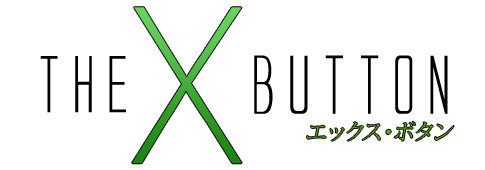
As a child of the fighting-game craze that slaughtered so many attention spans from 1991 to 1996, I would be remiss to start this column without mentioning that Super Street Fighter II Turbo HD Remix arrived on the PlayStation Network and Xbox Live today. For your $15 (or $14.99 on the PSN), you get a hi-definition remake of Super Street Fighter II Turbo with lots of online versus options and re-balanced gameplay that actually takes Akuma into account. It also looks like this.
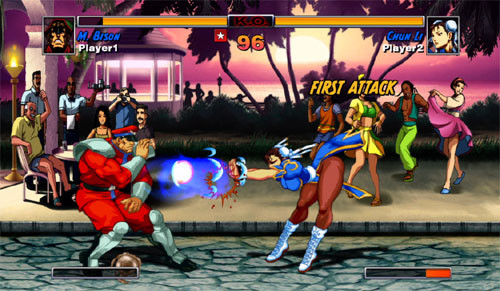
Some fans have nit-picked every minor anatomical exaggeration of the game's overhauled visuals, but I prefer to emphasize its gameplay, and how taking on all comers online will bring back those memories of pumping allowances into semi-reliable arcade machines. Of course, for the full effect you'll need to play SSFIITHDR with a spongy Fierce button, the scent of cheap, teenager-smoked cigarettes in the air, and an 11-year-old kid talking right behind you, his cracking, prepubescent voice explaining how Zangief sucks and how Cammy is hotter than Chun-Li. Just for the record, he doesn't and she isn't. But that's my 1993 self talking.
NEWS
YES, A PRINNY CAN BE THE HERO JUST THIS ONCE
 It's been far too long since a game starred a penguin. No, the Happy Feet games don't count. Get out. We've needed something like Prinny: Can I Really be the Hero? , a PSP side-scroller that puts the best Disgaea character(s) in the middle of action-platform levels. The Prinnies and their foes are hand-drawn sprites, while the stages fashion 2-D gameplay out of 3-D visuals, with the viewpoint twisting stylishly whenever the Prinny hero lands a particularly devastating aerial combo. A Prinny can even commandeer a demonic little tank straight out of Metal Slug.
It's been far too long since a game starred a penguin. No, the Happy Feet games don't count. Get out. We've needed something like Prinny: Can I Really be the Hero? , a PSP side-scroller that puts the best Disgaea character(s) in the middle of action-platform levels. The Prinnies and their foes are hand-drawn sprites, while the stages fashion 2-D gameplay out of 3-D visuals, with the viewpoint twisting stylishly whenever the Prinny hero lands a particularly devastating aerial combo. A Prinny can even commandeer a demonic little tank straight out of Metal Slug.
Prinny shipped in Japan just last week, but NIS America has its English version hitting here in February. Owners of Disgaea 3 can download the PSP game's lead Prinny, identified by his blood-red battle scarf, on the PlayStation Store starting November 28 (though that's most likely a Japan-only deal), and Prinny: Can I Really Be the Hero? will get a few downloadable stages and character cameos, including one by Disgaea 3's Mao, in due time. Etna, the Prinnies' dessert-hungry commander, already shows up in the game to kick the devil-penguins around, so it's anyone's guess as to who else NIS might cram in.
DETROIT METAL CITY NOW AN RPG
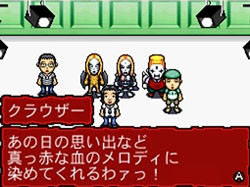 When D3 rolled out a DS title based on Detroit Metal City earlier this year, it appeared to be a basic rhythm game in the style of Elite Beat Agents. Yet that was a mere teaser. Now more than just a simple screen-tapping music simulator, Detroit Metal City: Death Shout has a Live Mode for gaudy concerts, a Cult Mode for simulating all sorts of theatrical death-rock depravity, and, most interesting of all, a Quest Mode where the members of Detroit Metal City march along city streets and get into fights straight out of 16-bit Final Fantasy games. D3's pointing at a Japanese release date this winter, but the game's seen several delays already. Perhaps they'll add support for the Guitar Hero DS game's special attachment.
When D3 rolled out a DS title based on Detroit Metal City earlier this year, it appeared to be a basic rhythm game in the style of Elite Beat Agents. Yet that was a mere teaser. Now more than just a simple screen-tapping music simulator, Detroit Metal City: Death Shout has a Live Mode for gaudy concerts, a Cult Mode for simulating all sorts of theatrical death-rock depravity, and, most interesting of all, a Quest Mode where the members of Detroit Metal City march along city streets and get into fights straight out of 16-bit Final Fantasy games. D3's pointing at a Japanese release date this winter, but the game's seen several delays already. Perhaps they'll add support for the Guitar Hero DS game's special attachment.
SHOCKING NEW CHARACTER UNVEILED FOR DISSIDIA
The lineup of heroes and villains for Square Enix's Dissidia: Final Fantasy was supposedly finished a few weeks ago, but the developers just can't stop cramming in familiar characters from past Final Fantasy games. So who's the newest addition? Balthier or Princess Bitch Ashe from Final Fantasy XII? Agrias, Mustadio, or the overpowered Orlandu from Final Fantasy Tactics? Shadow from Final Fantasy VI or Yuffie from Final Fantasy VII, since every fighting game needs a ninja?
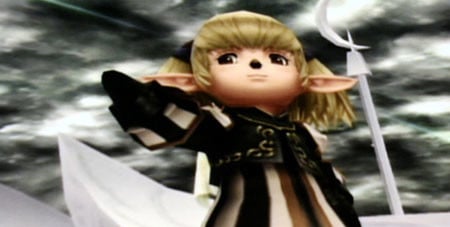
Oh. It's Shantotto, a Tarutaru NPC who figures into several quests from Final Fantasy XI. I realize that Square didn't want to skip Final Fantasy XI and that Shantotto is a major player in an upcoming FFXI expansion that sees her allegedly ruling an empire. I also realize that the game probably doesn't have any more memorable characters. Still, that's really no excuse for ignoring the more striking Final Fantasies in favor of a playable fighter that recalls nothing so much as Snarf from Thundercats.
INTERVIEW: DRAGON BALL Z: INFINITE WORLD
 Dragon Ball games are now a yearly fixture of the game industry, but it's rare that we get both the lighter Dragon Ball and the grunting, combat-heavy Z sequel adapted around the same time. Dragon Ball Origins, reviewed last week, fashions a new 3-D remake of the original series from the ground up, while Dragon Ball Z: Infinite World builds on previous accomplishments, namely the Budokai series of fighting games. It's very much in their tradition, with sharp-looking characters, plenty of atmospheric touches, and Harunobu Kageyama riffs. The gameplay is still focused on flashy attacks, mid-air sparring, and preset combos, which also ties into the Dragon Ball Z feel. It'll never be on par with the layers of Virtua Fighter 5 or even Soul Calibur, but Virtua Fighter doesn't let you knock your opponent three miles across a plain and into a mountain, all without actually ending the match. For a closer look at Infinite World's development, we went to Ryo Mito, the game's producer.
Dragon Ball games are now a yearly fixture of the game industry, but it's rare that we get both the lighter Dragon Ball and the grunting, combat-heavy Z sequel adapted around the same time. Dragon Ball Origins, reviewed last week, fashions a new 3-D remake of the original series from the ground up, while Dragon Ball Z: Infinite World builds on previous accomplishments, namely the Budokai series of fighting games. It's very much in their tradition, with sharp-looking characters, plenty of atmospheric touches, and Harunobu Kageyama riffs. The gameplay is still focused on flashy attacks, mid-air sparring, and preset combos, which also ties into the Dragon Ball Z feel. It'll never be on par with the layers of Virtua Fighter 5 or even Soul Calibur, but Virtua Fighter doesn't let you knock your opponent three miles across a plain and into a mountain, all without actually ending the match. For a closer look at Infinite World's development, we went to Ryo Mito, the game's producer.
The X Button: Dragon Ball Z Infinite World will be the eighth Dragon Ball Z fighter on the PlayStation 2, and probably the last for that system. How do you think Infinite World is different from the games that came before it?
Ryo Mito: In the story mode, which is called “Dragon Mission,” a player will be able to enjoy not only battle games but action games of the various episodes taken from Dragon Ball Z. Because of this mode, we were able to include the funny episodes of Dragon Ball Z so that a player can run after Bubbles or run on the Snake Way.
How do you decide which scenes from the series to turn into a mini-game?
In Dragon Mission you will be able to experience the story of Saiyan, Majin Buu and Dragon Ball GT episodes. Through our experience, we have chosen the episodes which we felt Dragon Ball Z fans would love to see in the game.
 What features does Infinite World borrow from other Dragon Ball Z games?
What features does Infinite World borrow from other Dragon Ball Z games?
We were able to create the battle system, which is speedy and easy to control, on the basis of our experience from the PS2 versions of the Budokai series and the PSP's Shin Budokai series. We also included that the ultimate-move scenes and customized skill system, which were well received in Budokai 3.
Of the new features you've put in the game, which do you think is the most interesting?
The various actions in Dragon Mission have never been included in previous Dragon Ball Z games so I think they will be very interesting new factors.
What fighting games outside of other Dragon Ball Z games do you look to for inspiration for Infinite World? Tekken? Virtual Fighter? Psychic Force?
We'd rather get battle game ideas from the Dragon Ball comics and anime's scenes than by taking material from other game series.
How do you balance a fighting game with so many characters?
In Infinite World there are more than 100 characters if you include transformed shapes, so it is hard work to do balancing. However, we would like players to be satisfied, so we adjust the balance one by one.
Who's your personal favorite Dragon Ball Z character?
My personal favorite is Vegeta. He is a prince of Saiyan, but in the end he became very humane.
RELEASES FOR THE WEEK OF 11-30
|
KINGDOM HEARTS: RE: CHAIN OF MEMORIES (Square Enix, PS2, $29.99)  Re: Chain of Memories has gotten surprisingly scant promotion for a game connected to Kingdom Hearts, Square's second-largest source of spin-offs and sequels. Perhaps that's because this is merely a PlayStation 2 remake of the Game Boy Advance game Kingdom Hearts: Chain of Memories, and even Square knows that a brand can only be pushed so often. That said, the original game was overhauled extensively in terms of presentation; the visuals come close to the standards of Kingdom Hearts 2, and the cast, led by Haley Joel Osment's Sora, returns to voice both shaggy-haired Final Fantasy-ish heroes and familiar Disney icons. The story, set in the space between the first two Kingdom Hearts titles, brought the ominous, unrealistically coiffed Organization XIII to the fore in the GameBoy Advance game, and little changes in the underlying plot of this Re version. Combat also remains much the same, as Sora, Donald, and Goofy smack around Heartless minions and other foes with both button-pounding and a card-based battle system. It's this last detail that annoyed some fans who tried the original Chain of Memories, so it's hard to say if the PS2 version will win them over. Re: Chain of Memories has gotten surprisingly scant promotion for a game connected to Kingdom Hearts, Square's second-largest source of spin-offs and sequels. Perhaps that's because this is merely a PlayStation 2 remake of the Game Boy Advance game Kingdom Hearts: Chain of Memories, and even Square knows that a brand can only be pushed so often. That said, the original game was overhauled extensively in terms of presentation; the visuals come close to the standards of Kingdom Hearts 2, and the cast, led by Haley Joel Osment's Sora, returns to voice both shaggy-haired Final Fantasy-ish heroes and familiar Disney icons. The story, set in the space between the first two Kingdom Hearts titles, brought the ominous, unrealistically coiffed Organization XIII to the fore in the GameBoy Advance game, and little changes in the underlying plot of this Re version. Combat also remains much the same, as Sora, Donald, and Goofy smack around Heartless minions and other foes with both button-pounding and a card-based battle system. It's this last detail that annoyed some fans who tried the original Chain of Memories, so it's hard to say if the PS2 version will win them over. Get Excited If: You can name half of Organization XIII from memory. No Googling. |
EXTRA LIVES: CITY HUNTER
 Could City Hunter ever succeed in North America? It might very well have during the 1980s or the early 1990s, when an enterprising company could license and dub City Hunter, The Dirty Pair, Cat's Eye, and other not-for-kids anime to air in late-night syndication, just after talk shows and Star Trek: The Next Generation. Of course, that never happened. By the time City Hunter and its unshakably '80s tone arrived in North America, it was almost 2000 and no one here cared, not when they could watch modern anime series or perhaps the live-action City Hunter movie where Jackie Chan turns into Chun-Li. No, City Hunter needed to hit the U.S. in the age of Miami Vice and Hunter and Sledge Hammer. If it had, Sunsoft might've turned its PC Engine City Hunter game into a TurboGrafx-16 title for America.
Could City Hunter ever succeed in North America? It might very well have during the 1980s or the early 1990s, when an enterprising company could license and dub City Hunter, The Dirty Pair, Cat's Eye, and other not-for-kids anime to air in late-night syndication, just after talk shows and Star Trek: The Next Generation. Of course, that never happened. By the time City Hunter and its unshakably '80s tone arrived in North America, it was almost 2000 and no one here cared, not when they could watch modern anime series or perhaps the live-action City Hunter movie where Jackie Chan turns into Chun-Li. No, City Hunter needed to hit the U.S. in the age of Miami Vice and Hunter and Sledge Hammer. If it had, Sunsoft might've turned its PC Engine City Hunter game into a TurboGrafx-16 title for America. At first, Sunsoft's City Hunter sticks comparatively close to Tsukasa Hojo's comics and their long-running, huge-in-Japan anime series: Ryo Saeba (“Joe Saeba” to English audiences) is a perpetually horny yet highly talented mercenary, offering his A-Team-grade services with the help of his quick-tempered manager Kaori and towering ally Umibozu (“Falcon” in the U.S.). A side-scrolling action title of simple aims, City Hunter gives Ryo three missions to be completed in any order, plus a fourth challenge unlocked only after the first batch is finished. All of them play much the same, having Ryo race through hallways, gun down purple-suited thugs, dodge lasers, and talk to scientists and secretaries. It all mimics Namco's Rolling Thunder series (and Capcom's Code Name: Viper) more than a little, with Ryo's pistol-wielding stance coming straight out of the Rolling Thunder stock pose library.
 Much like Rolling Thunder, City Hunter's PC Engine off-shoot hasn't aged terribly well. Despite the choice of which stage to tackle first, all of them are warrens of doors and staircases, with copious backtracking and repeated visual designs. Also disappointing are the weapons: Ryo eventually gets some heavy artillery, but his basic handgun seems rather short-range for a .357 magnum. And while he controls with adequate ease, the game's bizarre hit detection actually lets you gun down an enemy when he's standing just behind Ryo. Other strange moments pop up when Sunsoft pits Ryo against maniacal cyborgs and a giant living Minotaur statue.
Much like Rolling Thunder, City Hunter's PC Engine off-shoot hasn't aged terribly well. Despite the choice of which stage to tackle first, all of them are warrens of doors and staircases, with copious backtracking and repeated visual designs. Also disappointing are the weapons: Ryo eventually gets some heavy artillery, but his basic handgun seems rather short-range for a .357 magnum. And while he controls with adequate ease, the game's bizarre hit detection actually lets you gun down an enemy when he's standing just behind Ryo. Other strange moments pop up when Sunsoft pits Ryo against maniacal cyborgs and a giant living Minotaur statue.
Yet most of the game stays mundane, and that's the real problem. City Hunter was never stupidly excessive, but it's undeniably a piece of vintage '80s cheese, a show where the lecherous-but-capable hero once fired a bullet through his own hand just to hit a hostage-taker at the right velocity. Sunsoft's game rarely captures that all-important air of a pulp detective in bubble-economy Shinjuku. Most of the conversations are of the talking-head variety, and the game's story hits a rather disappointing ending where Ryo doesn't even fight the last boss. Perhaps the only faithful City Hunter element in the gameplay comes when Ryo's door-opening habits lead to an undressed and indignant woman, the sight of whom refills Ryo's life meter. Oddly enough, Sunsoft doesn't follow this scene up by showing Kaori's traditional bashing of Ryo with an enormous mallet, but that was funny approximately once back in 1988.
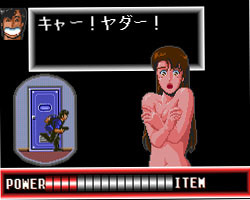 City Hunter's bland look can be partly blamed on its format. Anime-based games made the most of the PC Engine/TurboGrafx's CD attachment, using the then-revolutionary disc technology to pack in all sorts of video clips and voice acting. But City Hunter isn't a CD game; it's a HuCard, or a TurboChip, as the U.S. console's marketers sometimes called it. Barely larger than a credit card, the HuCard was a novel way to store games, but it was still just a cartridge, and it allowed little in the way of flashy footage or long audio clips. Still, that doesn't really excuse the soundtrack. There's a vaguely fitting beat in each level, yet none of the tracks comes close to City Hunter's “Get Wild” ending theme, which I'd dare to submit as the catchiest, most marvelously hokey anime single of the 1980s. The music here isn't terrible, but it's a low for Sunsoft, a developer that put some downright amazing tunes in NES games like Batman, Gremlins 2, and Journey to Silius.
City Hunter's bland look can be partly blamed on its format. Anime-based games made the most of the PC Engine/TurboGrafx's CD attachment, using the then-revolutionary disc technology to pack in all sorts of video clips and voice acting. But City Hunter isn't a CD game; it's a HuCard, or a TurboChip, as the U.S. console's marketers sometimes called it. Barely larger than a credit card, the HuCard was a novel way to store games, but it was still just a cartridge, and it allowed little in the way of flashy footage or long audio clips. Still, that doesn't really excuse the soundtrack. There's a vaguely fitting beat in each level, yet none of the tracks comes close to City Hunter's “Get Wild” ending theme, which I'd dare to submit as the catchiest, most marvelously hokey anime single of the 1980s. The music here isn't terrible, but it's a low for Sunsoft, a developer that put some downright amazing tunes in NES games like Batman, Gremlins 2, and Journey to Silius.
I doubt that Sunsoft ever considered City Hunter for the North American market. Nintendo's strict licensing policies often discouraged third-party publishers from bringing PC Engine games to the American TurboGrafx in 1990, and City Hunter would've been passed over anyway in favor of Sunsoft's Batman PC Engine game. Batman was a dull title full of mazes, but it had a license that was huge in the U.S. It also had good music.
City Hunter would've been better as a CD-based game, though being a humble HuCard makes it just a bit more notable today. The PC Engine's best games were on CDs, with the HuCard library remaining largely mediocre and under-realized. In a catalog like that, City Hunter stands out by reaching above-average territory, just as its namesake stands out for being slightly more fun than other disposable 20-year-old action anime series. Besides, it's hard to completely discard a City Hunter game that credits "sexy gals" and shows super-deformed Ryo and Kaori window-washing the screen whenever you pause it.
A City Hunter HuCard will run about $20, though some people apparently think a used copy with the box and manual is worth more than a fresh Fallout 3. It's not. If you seek out this or any other Japanese PC Engine titles, bear in mind that they'll need a pass-through adapter to work on an American system.
discuss this in the forum (33 posts) |
this article has been modified since it was originally posted; see change history